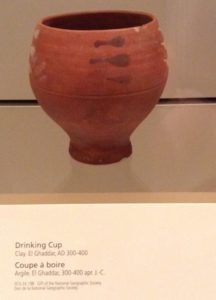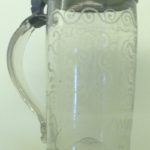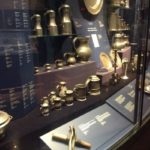 A few hours on the fourth floor of the Royal Ontario Museum Saturday found me looking for beer stuff in the exhibits. Just a game. You think of how pervasive beer has been in western culture and how places like museums like to not discuss it all that much and it starts to be a fun game to play for a tired mind after a long night in a noisy hotel. Fun? Time passing maybe. Temper maintaining perhaps. Anyway, there was some fairly interesting stuff to be found.
A few hours on the fourth floor of the Royal Ontario Museum Saturday found me looking for beer stuff in the exhibits. Just a game. You think of how pervasive beer has been in western culture and how places like museums like to not discuss it all that much and it starts to be a fun game to play for a tired mind after a long night in a noisy hotel. Fun? Time passing maybe. Temper maintaining perhaps. Anyway, there was some fairly interesting stuff to be found.
Like that friend of Bertie Wooster who passes time when walking through London by imagining golf shots, I think about the beers I would have from these museum pieces. Not hard when the drinking vessel in question is a 1750s Silesian glass tankard but what about a fourth century Sudanese clay drinking cup. Clay asks for something like thin boozy porridge but there’s not much of that going around these day in this civilization. Chip shot into the Shaftesbury Memorial pool at Piccadilly.
Then I think about the techniques the curators are using to get the beer stuff into the displays but not really mentioning. In one room of the exhibit, two Georgian silver tankards are in the back placed on bookshelves along with other curios as if they were not really used for drinking beer at all. In another display, pewter pots are lined up in a row to describe weights and measures as opposed to the uses to which they were put. The weighted and measured. Odd. No pottle. The fifteenth century mead drinking jug made of spruce sits next to the leather canteen in a daring juxtaposition of old things, weirdly shaped and made out of strange stuff. Two iron glanced off Shakespeare’s forehead neatly carries on down Charing Cross Road. Kids are getting tired feet. Me, too.
We took the subway back to the hotel, three stops south to Osgoode the TTC car as empty but for us as the sidewalks had been on the way north earlier. The kids said that Toronto was nice but it was no Montreal. I knew what they meant but it was not a bad Toronto, either. University Avenue looked like the MIT area of Cambridge if the MIT area of Cambridge had stopped being built in 1973 or so.




